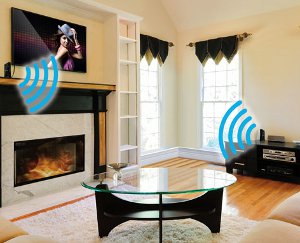Integrators need to educate customers better that ‘wireless’ audio does not mean ‘no new wires,’ and installing a cable-less system is not necessarily less labor intensive.
It is obvious many custom manufacturers of multiroom audio systems are pinning their hopes for 2014 on new wireless audio products. Wireless is a wonderful solution; it eliminates the need to pre-wire a house and can be installed as a retrofit. Now that video can be transmitted around the home via wireless, audio transmission should be a breeze.
However, not wanting to be a wet rag, I would suggest caution. If anything sounds too good to be true, you can bet there is more to the story. When it comes to distributing audio around the home without cables, we should have a look at the practical implications more carefully.
Wireless is Not 100% Reliable
Wireless, of course is not new. My first foray into it was in the late 1960s with a wireless remote volume control. It was a fantastic idea—a little box was placed between the pre and power amplifiers so the level could be adjusted from your armchair. It worked well most of the time, but not all the time. On occasion it was slow to respond, which was quite irritating. But the real problem was when you pushed the “up” button, on occasions, it did not stop and then it would continue to increase the level unaided to full output, often destroying very expensive speakers.
Through the years wireless has greatly improved, but in a world hungry for convenience, for every improvement in wireless technology there has be a consequential demand to make it deliver more. For that reason it has never been perfect. Maybe 99 percent right at times but never 100 percent.
You may ask why is 99 percent not a good result? Those experienced in remote systems are well aware how unforgiving consumers are if they are not directly in front of a component. Now with IP-based solutions, we have upped the ante transmitting audio wirelessly as well as system control through the home. As good as we are getting with latency, the slightest drop out of signal can be very frustrating to most consumers.
‘Wireless’ Does Not Mean ‘No Wires’
As convenient as it is, a smart installer knows wireless can be fickle and when problems arise it can expose them to a lot of hassle and call backs, so hardwiring will always be their preference. To consumers, wireless solutions mean “no need to wire at all” to save costs and absolve them from need to employ an integrator or electrician or do any forward planning. The consumer needs to be better informed.
Wireless moves the amplifier from the central equipment cabinet into each individual room, which was one of the important parameters when we developed A-BUS. (Editor’s Note: A-BUS technology has the power supply located at the hub end where there is access to power. It is then sent down the Cat 5 cable to the amplifier located in the room with the speakers. Without the power supply, it is small enough to fit behind a single-gang wall plate or on the back of a speaker.)
Being from an audiophile background, long runs of speaker cable around the home have always been an anathema to me. If it is accepted, you should use good quality speaker cable to prevent signal losses to your speakers when they are just across the room from the amplifier. Running poor quality speaker cable (as our industry does) to the other end of a house must be wrong. So why do we do it?
Let’s look at why. Where do you put an amplifier in a bathroom? Even in a bedroom where you normally have a closet space available, generally homeowners don’t like electrical components hidden away in them. Putting them in ceilings sitting next to the speakers amongst the insulation material can be messy. Centrally located amplifiers in an equipment closet and nasty long speaker cable runs have been the norm.
If finding an amplifier location is hard, finding a convenient power point for it is even harder. The situation is no different to the plethora of wireless speakers coming on the market implying “no wires required.” Of course there are wires; each speaker has a thick power cord running out the back of it looking for a power point. In multiroom audio this can be very inconvenient as it introduces the need for a high-voltage installer (electrician) to be involved in the installation procedure adding complexity and expense to the installation. If the employment of an electrician is to be avoided you, have to contend most power points are located at floor level and most multiroom audio speakers are located in ceilings. In between there is a cabling job to be done, so wireless is not necessarily cableless!
Bluetooth Connectivity is in Demand
Wireless definitely has its place when used properly. Bluetooth in most instances simply replaces the need for a patch lead. It is designed to work within a room over a short distance, making it highly reliable. Now your phone has become your personal entertainment system, having a local Bluetooth wireless connection in each room is becoming a very important consumer feature.
So where is the wireless cost savings? First look at the additional cost of a power point per room and second at wiring additional IP points—a sensible installer wouldn’t risk a “wireless only” installation. Then look at the higher cost of amplification each with its own power supply and weigh these factors against cost of running cable.
I think we forget the origins of the custom market. It grew out of the consumer’s desire to eliminate messy wires and black boxes around the home. With our current rush to adopt new wireless technology, the industry and consumer appears to have lost sight of our most important goal; that is to provide “invisible home entertainment.”
By Andrew Goldfinch
http://www.cepro.com/article/wireless_is_it_really_as_good_as_it_sounds/K536




